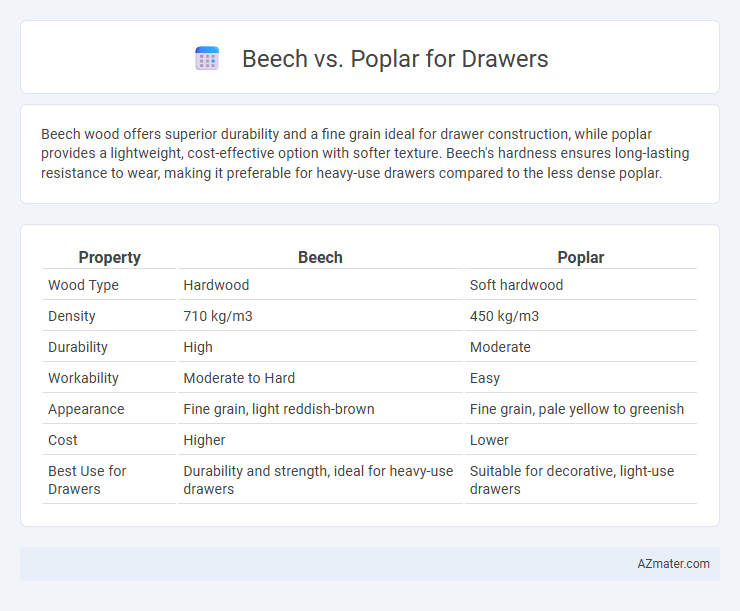Beech wood offers superior durability and a fine grain ideal for drawer construction, while poplar provides a lightweight, cost-effective option with softer texture. Beech's hardness ensures long-lasting resistance to wear, making it preferable for heavy-use drawers compared to the less dense poplar.
Table of Comparison
| Property | Beech | Poplar |
|---|---|---|
| Wood Type | Hardwood | Soft hardwood |
| Density | 710 kg/m3 | 450 kg/m3 |
| Durability | High | Moderate |
| Workability | Moderate to Hard | Easy |
| Appearance | Fine grain, light reddish-brown | Fine grain, pale yellow to greenish |
| Cost | Higher | Lower |
| Best Use for Drawers | Durability and strength, ideal for heavy-use drawers | Suitable for decorative, light-use drawers |
Overview: Beech vs Poplar for Drawer Construction
Beech offers a dense, durable hardwood ideal for drawer construction, providing strong resistance to wear and excellent stability under load. Poplar, a softer hardwood, is easier to work with and more cost-effective but may dent or scratch more quickly compared to beech. Choosing between beech and poplar depends on balancing durability requirements and budget constraints for drawer projects.
Wood Hardness and Durability Comparison
Beech wood exhibits a higher Janka hardness rating of approximately 1,300 lbf, making it significantly harder and more resistant to dents compared to poplar's 540 lbf, which is relatively soft. In terms of durability, beech offers superior wear resistance and longevity in drawer construction, maintaining structural integrity under frequent use. Poplar, while easier to work with and lighter in weight, tends to show wear and dents faster, reducing its overall lifespan in high-traffic applications like drawers.
Workability and Machining Differences
Beech wood offers superior workability with its fine grain and hardness, allowing for smooth machining and precise detailing in drawer construction. Poplar, being softer and more porous, machines easily but is prone to dents and lacks the fine finish achievable with Beech. The machining of Beech results in cleaner cuts and better screw holding strength, making it a preferred choice for durable drawer components.
Cost and Availability Analysis
Beech wood typically ranges from $3 to $6 per board foot, offering a durable and dense material frequently used in high-quality drawer construction, with widespread availability in North America and Europe. Poplar is generally more cost-effective, priced between $1.50 to $3 per board foot, and is softer and easier to work with, making it a popular choice for budget-friendly drawers and mass production due to its abundant availability. The cost-efficiency of poplar is offset by its lower hardness and durability compared to beech, which commands a higher price reflecting its superior strength and longer lifespan.
Finishing and Appearance: Which Looks Better?
Beech wood offers a smooth, fine grain with a light, warm color that accepts stains and finishes evenly, resulting in a clean, polished look ideal for traditional or modern drawers. Poplar typically has a more inconsistent grain and varies in color from pale green to brown, often requiring paint or veneer for a uniform appearance, making it less suitable for natural finishes. For drawer finishing and appearance, beech wood is preferred due to its consistent grain pattern and superior stain absorption, providing a more refined and aesthetically pleasing outcome.
Strength and Load-Bearing Capabilities
Beech wood exhibits superior strength and higher load-bearing capabilities compared to poplar, making it ideal for drawers subject to heavy use. Its dense grain structure provides enhanced durability and resistance to wear, supporting substantial weight without warping or deforming. Poplar, while lightweight and easier to work with, lacks the firmness necessary for high-load applications and is better suited for decorative drawer parts or light-duty components.
Resistance to Warping and Moisture
Beech wood exhibits superior resistance to warping and moisture compared to Poplar, making it a more stable choice for drawers exposed to varying humidity levels. Poplar tends to absorb moisture more readily, increasing the risk of swelling and deformation over time. Choosing Beech ensures long-lasting structural integrity and minimal dimensional changes in drawer construction.
Environmental Impact and Sustainability
Beech wood, known for its density and durability, comes from sustainably managed European forests with a relatively low environmental footprint due to efficient growth cycles and responsible harvesting. Poplar, a fast-growing hardwood primarily sourced from North American plantations, offers a renewable option with a shorter maturation period, which aids carbon sequestration and reduces habitat disruption. Choosing either species for drawers depends on prioritizing slower growth with longer lifespan (Beech) versus rapid renewability and lower immediate impact (Poplar) within eco-conscious woodcraft.
Best Use Cases: When to Choose Beech or Poplar
Beech wood, known for its hardness and fine grain, is best suited for drawer construction requiring durability and a smooth finish, ideal for high-use furniture pieces. Poplar, being softer and easier to machine, excels in projects where intricate designs or painted surfaces are desired, making it a cost-effective choice for decorative drawers. Choose Beech for strength and wear resistance, and opt for Poplar when prioritizing affordability and ease of customization.
Expert Recommendations and Final Verdict
Experts recommend beech for drawer construction due to its dense grain, durability, and resistance to wear, making it ideal for high-usage furniture. Poplar, while easier to machine and more affordable, lacks the hardness of beech and can dent or scratch more easily under frequent use. The final verdict favors beech as the superior choice for long-lasting drawers requiring strength and resilience in everyday function.

Infographic: Beech vs Poplar for Drawer
 azmater.com
azmater.com